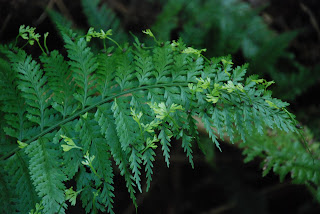Once Paul finished grading final tests, we headed for the Catlins at the bottom of the south island. The Catlins is a scenic region with a lot of good things to see - waterfalls, coastline, caves, hill country, and interesting people. We took the Intercity bus down from Christchurch to Dunedin, then rented a car and drove down through Balclutha and into the Catlins.
Our first stop was the Nugget Point lighthouse. Nugget Point has a large number of boulders off the point (the nuggets) and a now-automated lighthouse to warn the coastal boaters. It's another beautiful spot out of many on the south island.
We stayed at a backpackers called the
Hilltop Accommodations just outside of the small town of Papatowai. We were greeted by a field of sheep, and ended up being the only ones there that night. The lower building is a wonderful old house high on a hillside, with a great view of the valley and out to the sea.
The next morning we went to the nearby
Purakaunui Falls, which is a nice multi-tiered falls but probably more spectacular when the water is running at a higher volume.
We then visited the amazing Lost Gypsy Gallery in Papatowai. Blair Somerville is an artist who blends various pieces of technology into artwork. He has a museum of sorts in an old bus which contains many interesting windup creations, but the real treat is his outdoor theatre with some awe-inspiring larger pieces, including a piano with each key starting up a piece of technology to make an unique sound. If you're interested in the unusual, the interesting, or the just plain fun, this is definitely worth a stop.
We then drove to Curio Bay at low tide to see a fossilised forest on the ocean shore. Trees (both fallen and standing) were covered in sediment 180 million years ago, and you can see trunks and stumps petrified in the rock surface on the shore.
We were sorry to leave the Catlins, but had to leave other sights for next time. We drove through Invercargill to the airport, and caught a short flight out to Stewart Island.
Stewart Island is the third largest island in New Zealand, about 30 km. off of the bottom of the south island. It has about 400 permanent residents, and a small number of tourists when we were there (would be much busier in the summer). About 85% of the island is national park, and there are a number of good walking trails both in the main settlement of Oban, in the surrounding area, and around the whole island. We walked on two of these (the Fuschia Walk and the Raroa Walk) the first night, and saw both the local species of parrot (kaka) and the black and white tui. The tui mimics other birds and also has a call that sounds like R2D2 from the Star Wars movies.
The next day we booked a half-day birding trip through
Ruggedy Range Expeditions to Ulva Island, which sits in the middle of the Paterson Inlet that cuts into Stewart Island. All mammals have been removed from Ulva Island (with the exception of periodic rat infestations that are controlled with traps and poison). The Department of Conservation has reintroduced native birds that had been forced off the island by mammalian predators. We saw the "big four" that our guide Furhana was looking for (birds with the interesting names of rifleman, saddleback, yellowhead, and a red-crested parakeet), plus a variety of others, including the New Zealand robin, bellbird, grey warbler, tui, brown creeper (different than the US version), and a morepork (a New Zealand owl whose call sounds like "more-pork"). We were on this trip with two birders from Wales who were in New Zealand for the Rugby World Cup (Wales came in fourth).
The second day we visited a local native-plant garden, and then did a half-day walk on the track from Half Moon Bay to Horseshoe Bay. This is a beautiful walk that weaves in and out of bush and coast.
The third day we walked on another trail on the edge of town, hearing and seeing many more tui, before heading back into Oban. We were hesitant to leave - Stewart Island is a beautiful and relaxing place to visit, and the people start getting to know you after only a few days in their community. We caught our return flight back to Invercargill, picked up our car and drove back on Highway 1 to Dunedin.



































